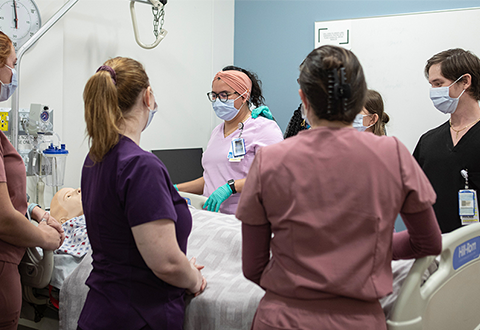Telestroke training key in caring for Veterans

Nurse residents treat a practice patient during a simulation at the West Palm Beach VA. Photo by Alvaro Galan, Digital Media Specialist, West Palm Beach VA Healthcare System
With machines humming and equipment beeping, the simulation lab seemed just like a hospital room. Thumping quicker than the machines were the hearts of nurse residents like Wade Parker at the West Palm Beach VA Medical Center as they gathered around the live practice patient. Parker felt nervous, but excited, knowing the training they were about to receive could one day save lives. Then it happened—the code “stroke” was called.
According to the American Stroke Association, strokes are the fifth cause of death and leading cause of disability in the United States. When a stroke happens, time is essential to the health of the patient. That’s where Telestroke training comes into play.
The Veterans Health Administration (VHA) National Telestroke Program (NTSP) is a service of VA that provides acute stroke care to Veterans at VA facilities that do not have a neurologist available. Using telehealth technologies, a neurologist from the NTSP center can evaluate patients and provide a treatment plan for the on-site staff to complete.
“The NTSP provides VA facilities with 24-hour, seven-days-a-week stroke neurology services using telehealth technologies to ensure all Veterans have access to expert acute stroke care all year round,” said Dr. Jane Anderson, director of Program Development and Evaluation for the NTSP.
The benefit of having on-site care prevents unnecessary hospital transfers and increases care efficiency for the Veteran. Anderson noted results from VA facilities who participated in the program since 2018, saying the training “created confidence, instilled motivation, and improved communication while using tele-technology.”
For Parker, who has been with the VA in a residency program for about four months, seeing the stroke simulation and training provided a good understanding of how the process works when a patient shows signs of a stroke.
“Having a new onset stroke patient has always been a fear of mine,” said Parker. “Strokes are very serious and time sensitive. Getting to see what goes on and happens during the code stroke was very informative and made me feel more confident about caring for a stroke patient.”
Parker believed the training was both realistic and helpful. “We had our instructors around to guide us if needed, but we were running the code ourselves and making sure the patient had the best outcome. In the end, we finished the simulation within the 45 minutes required and the patient showed improvement after the alteplase was administered.”
NTSP Stroke Coordinator Jill Stouffer, RN, led the training at West Palm Beach VA after a request for a mock simulation for the nurse residency program. Stouffer thought this was a great idea because nursing students do not usually get the opportunity to use Telestroke in clinicals. “Overall, I thought the simulations went very well,” said Stouffer. “The nursing residents were able to ask me questions as we went through the scenario which is very helpful in the learning process.”
Stouffer, who loves teaching and “passing the torch to the next generation,” thought the West Palm Beach simulation went well due to the collaborative effort and teamwork. “During the debrief, the nursing residents were able to teach back the counterindications to given alteplase. I was very impressed,” said Stouffer. “I feel they were at ease and the teamwork was outstanding.”
For West Palm Beach VA Education Coordinator, Dr. Christin Protesto, the importance of Telestroke simulation training is a necessity and is especially important for new graduate RN residents.
“Many of our on-site providers and nurses have not yet witnessed the VHA National Telestroke service or collaborated in a live telehealth assessment,” said Protesto. “Not only is simulating how to respond and properly assess a patient when a stroke is suspected important to learn, but simulating remote collaboration is also an important skill to learn.”
Parker appreciates the opportunity to practice the lifesaving skills the recent simulation provided him and his fellow residents. “I absolutely think that this simulation better prepared me for a real-life stroke,” said Parker. “Just having a basic understanding of the equipment, the types of questions to ask the patient, and the timeframe of what needs to occur and who needs to be called, makes me feel much better as a nurse.”
Parker is grateful knowing the training will help provide stroke victims the best possible outcome and they can continue to live a healthy life. “It was good to know that we are not alone in [stroke] codes and will always have the help of the Telestroke hotline to guide us and keep the patients safe.”
VA is a national leader in health professions education, setting the standard for physicians and health professions training in more than 60 professions with more than 1,500 educational institution affiliates to train future health professionals. These academic affiliations, some of which began more than 78 years ago, are coordinated by VA’s Office of Academic Affiliations (OAA). Find out more about VA’s academic mission by visiting the OAA website.



















